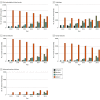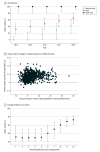Clinician Trends in Prescribing Direct Oral Anticoagulants for US Medicare Beneficiaries
- PMID: 34870678
- PMCID: PMC8649845
- DOI: 10.1001/jamanetworkopen.2021.37288
Clinician Trends in Prescribing Direct Oral Anticoagulants for US Medicare Beneficiaries
Abstract
Importance: Contemporary national clinical practice guidelines recommend direct-acting oral anticoagulants (DOACs) as the first-line anticoagulant strategy over warfarin for most indications, especially among older individuals with an elevated bleeding risk.
Objective: To evaluate anticoagulant prescribing and DOAC uptake by US clinicians in the Medicare population.
Design, setting, and participants: This retrospective cohort study included all US clinicians with more than 10 Medicare oral anticoagulant prescription claims, who were included in the national Medicare Provider Utilization and Payment Data (2013-2018). Data analyses were conducted between October 2020 and October 2021.
Exposures: DOAC prescription in 2013.
Main outcomes and measures: Clinicians were categorized based on 2013 prescribing as solely prescribing warfarin, DOAC, or both, and their temporal trajectories of proportionate DOAC use were examined.
Results: The analysis included 325 666 unique clinicians with more than 10 oral anticoagulant prescriptions between 2013 and 2018 (26 620 [8.2%] cardiologists, 85 563 [26.3%] internal medicine physicians, 84 369 [25.9%] family medicine physicians, and 81 161 [24.9%] advanced practice clinicians, including nurse practitioners and physician assistants). In 2013, among 91 837 prescribers, 54 501 (59.3%) prescribed only warfarin, 1918 (2.1%) prescribed only a DOAC, and 35 418 (38.6%) prescribed both. During the study period, the number of clinicians prescribing DOACs increased, but 19% continued to prescribe only warfarin in 2018. While 359 cardiologists prescribing anticoagulants (1.6%) were warfarin-only prescribers, 10 414 (20.0%) and 6296 (12.6%) of family and internal medicine physicians also prescribed only warfarin, respectively. Clinicians prescribing only warfarin in 2013 had lower proportionate DOAC use throughout the study compared with 2013 DOAC prescribers, which represents a median (IQR) of 41.9% (20.3%-61.9%) of their anticoagulant prescriptions in 2018 vs 67.0% (49.9%-82.8%) for DOAC prescribers.
Conclusions and relevance: Despite the increase in DOAC use among Medicare beneficiaries, many clinicians in this study continued to use warfarin as their predominant or only anticoagulant instead of DOACs. There is a need to address barriers to the uptake of these medications to realize their potential benefits for patients.
Conflict of interest statement
Figures



References
Publication types
MeSH terms
Substances
Grants and funding
LinkOut - more resources
Full Text Sources
Medical

